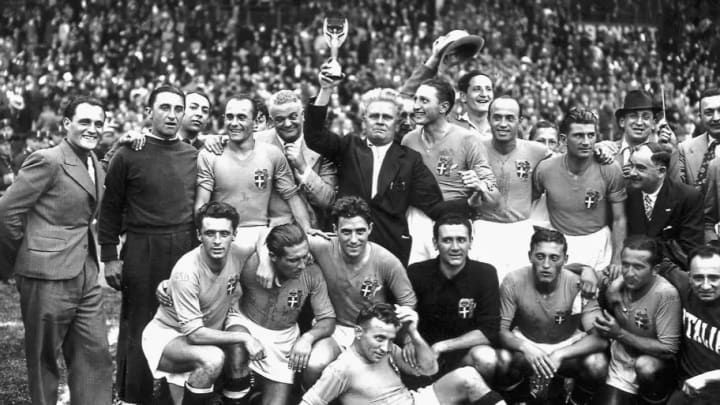World Cup Countdown: 19 Weeks to Go - Vittorio Pozzo's 1934 Italian Tactical Revolution

'Il Vecchio Maestro' - the old master - was a title accredited to a true pioneer in Italian football: Vittorio Pozzo.
A majestic manager, whose grasp on the beautiful game forged new-found ideologies and boundaries, ones that would see him regarded as one of the greatest tacticians of his time, and continue to today.
However, it was not on the shores of his home nation where he discovered his true calling, but on England's, with the unrepentant Anglophile inspired by Manchester United's centre-half Charlie Roberts so much so, a new age of football was born.
(You may also be interested in 'World Cup Countdown: 19 Weeks to Go - Remembering the 'Italian Stallion' Giuseppe Meazza')
Following a playing career spanning six years, which consisted of spells at Grasshopper Club Zurich and Torino, Pozzo was determined to ingrain football into general society across his home peninsula and volunteered to coach the Italian national team at the Olympics of 1912 in Stockholm.
Despite succumbing to defeat in the opening round, Italy, led by il Vecchio Maestro, returned to the Games again four years later in Paris, this time winning a bronze medal. But, it was 1929 where the real story begins.
On completion of managerial posts at both Torino and AC Milan, 'the old master' was named the first head coach of Azzurri not to be shackled by the decision-making of a technical committee.
LE SAVIEZ-VOUS ?
— Coupe du Monde 🏆 (@fifaworldcup_fr) January 10, 2018
Grâce aux victoires lors des Coupes du Monde 1934 et 1938, Vittorio Pozzo est le seul à avoir remporté deux fois la compétition en tant que sélectionneur. #MercrediSagesse #WednesdayWisdom ⚽🇮🇹🏆🏆 pic.twitter.com/dCf72bC5l8
(You may also be interested in 'World Cup Countdown: 19 Weeks to Go - Italy & Mussolini's First International Triumph')
The inaugural 1930 World Cup passed the Italians by, with the Uruguay-based tournament seemingly not of significant enough interest to distract Pozzo from his tactical mandate.
However, in the four years following, Metodo was born. A system which went against all that had gone before. One focused more on the importance of defence, compared to the five-in-attack international outfits throughout the world had adopted.
While loosely based on the aforementioned forward-dominant set up, the Torinese's masterplan included two deeper-lying line leaders, much like an attacking midfielder, as we would refer to them today.
This pairing became known as 'inside forwards', and crucially, in essentially what as a 2-3-2-3 formation, it offered Azzurri far greater flexibility when combating the more habitual 2-3-5 system.
Em 21 de dezembro de 1968, o futebol perdia um de seus mais icônicos personagens: Vittorio Pozzo, um dos fundadores do Torino FC e técnico da Itália dos anos 30. Ele foi o primeiro e único treinador bicampeão consecutivo da Copa do Mundo! Relembre! https://t.co/KuYiiqMzgo pic.twitter.com/PHfR27SNe0
— Imortais do Futebol (@imortaisfutebol) December 21, 2017
But Pozzo's tactical brainchild was not complete, as with a shallower attacking line came alongside it the opportunity to integrate ball-playing centre-halves, an idea crafted while entranced in the technical mastery of Manchester United's Roberts.
Metodo was complete. An inconceivable, trailblazing tactical creation which would set a precedent amongst international football. However, at the time it was simply a philosophy created under the scrutinous eye of dictator Benito Mussolini and the Italian nation, so, would it work?
The 1934 World Cup was upon 'the old master'. Added pressure of Azzurri hosting the tournament seemed to hold no influence, as they cantered past Greece 4-0 in qualifying and the United States 7-1 in the first round.
However, Spain proved a much trickier test to overcome in the following quarter-final, as following 120 minutes of gruelling football, the pairing could not be separated. It was decided that following the 1-1 draw all would reconvene again 24 hours later to find a victor.
As it was, the timeframe was too taxing for 11 players, four Italian and seven Spanish, however Giuseppe Meazza, a flag bearing 'inside right' of Metodo, was not one of those, and netted the only goal of the relatively deadened rematch.Following Pozzo's victory over Spain, he was then faced with the challenge of friend and rival Hugo Meisl and his Austrian 'Wunderteam' - who, like Italy, were in strong contention to be crowned world champions leading into the tournament.
The high-profile semi-final, however, failed to live up to expectation for the most part, with a dubious 10th-minute strike from one of the team's many oriundi (South American-born Italian nationals), Enrico Guaita sealing the win. But the responsibility of the lacklustre affair fell on one man, another oriundi in fact, Luisito Monti - who had featured for Argentina during the 1930 World Cup - as the playmaking centre-half, who was imperative in Pozzo's genius, produced an inspirational display to mute the attacking threat from Meisl's 'Wunderteam'.
Ricordando il ct Vittorio Pozzo http://t.co/CqxHkpNVun pic.twitter.com/jHIQmeyOjI
— Torino Sette (@TorinoSette) April 10, 2015
Following their conquering of Austria, lay ahead was a dexterous Czech team in the final, who eventually fell to il Vecchio Maestro and his Azzurri army after Roma winger Angelo Schiavio snatched the spoils in the fifth minute of added time.
The full-time whistle sparked scenes on unrivalled jubilation, with Pozzo riding his sea of stars while being awarded the title Commendatore. But much like any true great, 'the old master' believed his best was yet to come, and so it proved.